Analytical Method for Calculating Sustainable Airport Capacity
Abstract
1. Introduction
- Demand growth forecasts that should be met [4];
- Adoption of new procedures to which the airport is forced to submit (for example, they may concern ground handling, approach or removal procedures);
- Any delays in operations, caused by the current traffic demand, that influence the value of sustainable airport capacity (i.e., according to Airport Cooperative Research Program (ACRP) Report 104, “a measure of the hourly capacity that can realistically be achieved for several consecutive hours” [5]; it is generally 10–20% lower than saturation capacity);
- Issues in terms of safety, environment and cost in order to minimize their burdens.
- Level 1: Table lookup. The actual configuration is compared to a standard one. This level is suitable for runways only and simply airfields and only minimal information on runway configuration and aircraft fleet mix are required. Chapter 2 of FAA AC 150/5060-5 [2] provides an example of level 1 analysis.
- Level 2: Charts, monographs and spreadsheets. This level is suitable for runways only and simply airfields, but the input data require a better knowledge of the traffic in the airport and more information on the airport layout (taxiways and gates). Chapter 3 of FAA AC 150/5060-5 [2] presents an example of level 2 analysis.
- Level 3: Analytical capacity models. Even if level 3 is suitable for runways only, it allows the analysis of moderate size airports and some more information in inputs on aircraft fleet mix, aircraft final approach speeds, aircraft separations, and air traffic control (ATC) rules.
- Level 4: Airfield capacity simulation models. Capacity planning of complex airfields or regional airfield/airspace systems can be carried out and it requires more detailed input data than the previous levels. Arrival and departure flight track geometries and aircraft fleet mix by runway shall be known in addition to the complete airport configuration.
- Level 5: Aircraft delay simulation models. These models, also called Fast Time Simulation (FTS), are the most advanced tools for the study of the whole airport. The capacity assessment of complex airfields or regional airfield/airspace systems can be performed and the greatest level of detail about aircraft flight schedule and airfield and airspace configurations, including taxiing routes and aircraft parking position area required [17,18,19].
2. Methods
- Probabilistic sequencing of operations (arrival/departure): the actual traffic mix monitored in the airport is analyzed according to the six WTC to obtain the Pij matrix that describes the probabilities of presence of a class “i” aircraft (leader aircraft) followed by a “j” class aircraft (follower aircraft);
- Continuous demand of arrivals: local problems or interference which can reduce landing operations are neglected;
- Continuous demand of departures: in this case, local problems or interferences that can reduce take-off operations are also neglected;
- Analytical evaluation of the runway occupancy time (ROT) for each WTC;
- Constant aircraft speed along the terminal approach path equal to the certified approach speed (Vapp) for each WTC;
- Ideal weather conditions.
- δ = minimum separation distance specified by air traffic rules;
- γ = length of the terminal approach path;
- vj = speed of the follower plane.
- Take-offs can be independent if the runway distance is greater 760 m and the routes divergences is greater than 15° (Figure 2);
- Landing can be independent if the runway distance is greater 1310 m, otherwise a “chessboard” configuration has to be considered. With this aim, the model takes this into account a minimum diagonal spacing d2. This allows for having a distance between two approaching aircraft on the same runway compatible with the movement of other planes landing on the adjacent runway (Figure 3).
3. Case Study
- Scenario 1: two-runway configuration with segregated use;
- Scenario 2: two-runway configuration with mixed mode use;
- Scenario 3: three-runway configuration with mixed mode use of one runway and segregated of the other two.
4. Result and Discussion
5. Conclusions
Author Contributions
Funding
Conflicts of Interest
References
- IATA. Word Air Transport Statistics. Available online: https://www.iata.org/en/publications/store/world-air-transport-statistics/ (accessed on 10 February 2020).
- Federal Aviation Administration. Airport Capacity and Delay; AC: 150/5060-5; U.S. Department of Transportation, Federal Aviation Administration: Washington, DC, USA, 1983. Available online: https://www.faa.gov/documentLibrary/media/Advisory_Circular/150_5060_5.pdf (accessed on 5 November 2020).
- De Neufville, R.; Odoni, A.R. Airport Systems: Planning, Design and Management, 2nd ed.; MacGraw Hill: New York, NY, USA, 2003; ISBN 978-0-07-177058-3. [Google Scholar]
- Tascón, D.C.; Díaz Olariaga, O. Air traffic forecast and its impact on runway capacity. A System Dynamics approach. J. Air Transp. Manag. 2021, 90, 101946. [Google Scholar]
- ACRP. Defining and Measuring Aircraft Delay and Airport Capacity Thresholds; Report 104; Transportation Research Board: Washington, DC, USA, 2014. [Google Scholar]
- Ashford, N.J.; Coutu, P.; Beasley, J.R. Airport Operations, 3rd ed.; McGraw-Hill Education: New York, NY, USA, 2012. [Google Scholar]
- Horonjeff, R.; McKelvey, F.; Sproule, W.J.; Young, S.B. Planning & Design of Airports, 5th ed.; Mc Graw Hill: New York, NY, USA, 2010. [Google Scholar]
- Di Mascio, P.; Cervelli, D.; Comoda Correra, A.; Frasacco, L.; Luciano, E.; Moretti, L. Effects of Departure MANager (DMAN) and Arrival MANager (AMAN) systems on airport capacity. J. Airpt. Manag. 2021. accepted paper. [Google Scholar]
- Di Mascio, P.; Carrara, R.; Frasacco, L.; Luciano, E.; Moretti, L.; Ponziani, A. Influence of Tower Air Traffic Controller workload and airport layout on airport capacity. J. Airpt. Manag. 2021. accepted paper. [Google Scholar]
- Eurocontrol. Airport Capacity Assessment Methodology; ACAM Manual; v.1.1; Eurocontrol: Brussels, Belgium, 2016; Available online: https://www.eurocontrol.int/sites/default/files/publication/files/nom-apt-acap-acamman-v1-1.pdf (accessed on 5 November 2020).
- Graham, B.; Guyer, C. Environmental sustainability, airport capacity and European air transport liberalization: Irreconcilable goals? J. Transp. Geogr. 1999, 7, 165–180. [Google Scholar]
- Stanners, D.; Bourdeau, P. (Eds.) Europe’s Environment: The Dobris Assessment; Office for Official Publications of the European Communities: Luxembourg; European Environment Agency: Copenhagen, Denmark, 1995. [Google Scholar]
- Ivković, I.; Čokorilo, O.; Kaplanović, S. The estimation of GHG emission costs in road and air transport sector: Case study of Serbia. Transport 2018, 33, 260–267. [Google Scholar]
- Button, K.; Nijkamp, P. Social change and sustainable transport. J. Transp. Geogr. 1997, 5, 215–218. [Google Scholar]
- Čokorilo, O.; Dell’Acqua, G. Aviation Hazards Identification Using Safety Management System (SMS) Techniques. In Proceedings of the 16th International Conference on Transport Science ICTS 2013, Portorož, Slovenia, 27 May 2013; pp. 66–73. [Google Scholar]
- Čokorilo, O. Human Factor Modelling for Fast-Time Simulations in Aviation. Aircr. Eng. Aerosp. Technol. 2013, 85, 389–405. [Google Scholar]
- Bubalo, B.; Daduna, J.R. Airport capacity and demand calculations by simulation—The case of Berlin-Brandenburg International Airport. NOTNOMICS Econ. Res. Electron. Netw. 2011, 12, 161–181. [Google Scholar]
- Ignaccolo, M. A simulation model for aiport capacity and delay analysis. Transp. Plan. Technol. 2003, 26, 135–170. [Google Scholar]
- ACRP. Evaluating Airfield Capacity. Transportation Research Board; Report 079; Transportation Research Board: Washington, DC, USA, 2012. [Google Scholar]
- FAA. Pilot and ATC Guide to Wake Turbolence. 2016. Available online: https://www.faa.gov/training_testing/training/media/wake/04sec2.pd (accessed on 17 February 2020).
- Eurocontrol. European Wake Turbulence Categorisation and Separation Minima on Approach and Departure, 1st ed.; Eurocontrol: Brussels, Belgium, 2015; Available online: https://www.eurocontrol.int/publication/european-wake-turbulence-categorisation-and-separation-minima-approach-and-departure (accessed on 5 November 2020).
- NASA. Estimating the Effects of the Terminal Area Productivity Program; s.n. 201682; NASA Langley Technical Report Server: Hampton, VA, USA, 1997.
- Cavusoglu, S.S.; Macario, R. Minimum delay or maximum efficiency? Rising productivity of available capacity at airports: Review of current practice and future needs. J. Airpt. Manag. 2021, 90, 101947. [Google Scholar]
- Di Mascio, P.; Cervelli, D.; Comoda Correra, A.; Frasacco, L.; Luciano, E.; Moretti, L.; Nichele, S. A critical comparison of airport capacity studies. J. Airpt. Manag. 2020, 14, 307–321. [Google Scholar]
- Federal Aviation Administration. Parameters of Future ATC Systems Relating to Airport Capacity/Delay; EM-78-8A; U.S. Department of Transportation, Federal Aviation Administration: Washington, DC, USA, 1978. Available online: http://www.tc.faa.gov/its/worldpac/techrpt/em78-8a.pdf (accessed on 5 November 2020).
- International Civil Aviation Organization. Manual on Simultaneous Operations on Parallel or Near-Parallel Instrument Runways (SOIR); Doc 9643 AN/941; International Civil Aviation Organization (ICAO): Montreal, QC, Canada, 2004. [Google Scholar]
- Moretti, L.; Di Mascio, P.; Bellagamba, S. Environmental, Human Health and Socio-Economic Effects of Cement Powders: The Multicriteria Analysis as Decisional Methodology. Int. J. Environ. Res. Public Health 2017, 14, 645. [Google Scholar] [CrossRef]
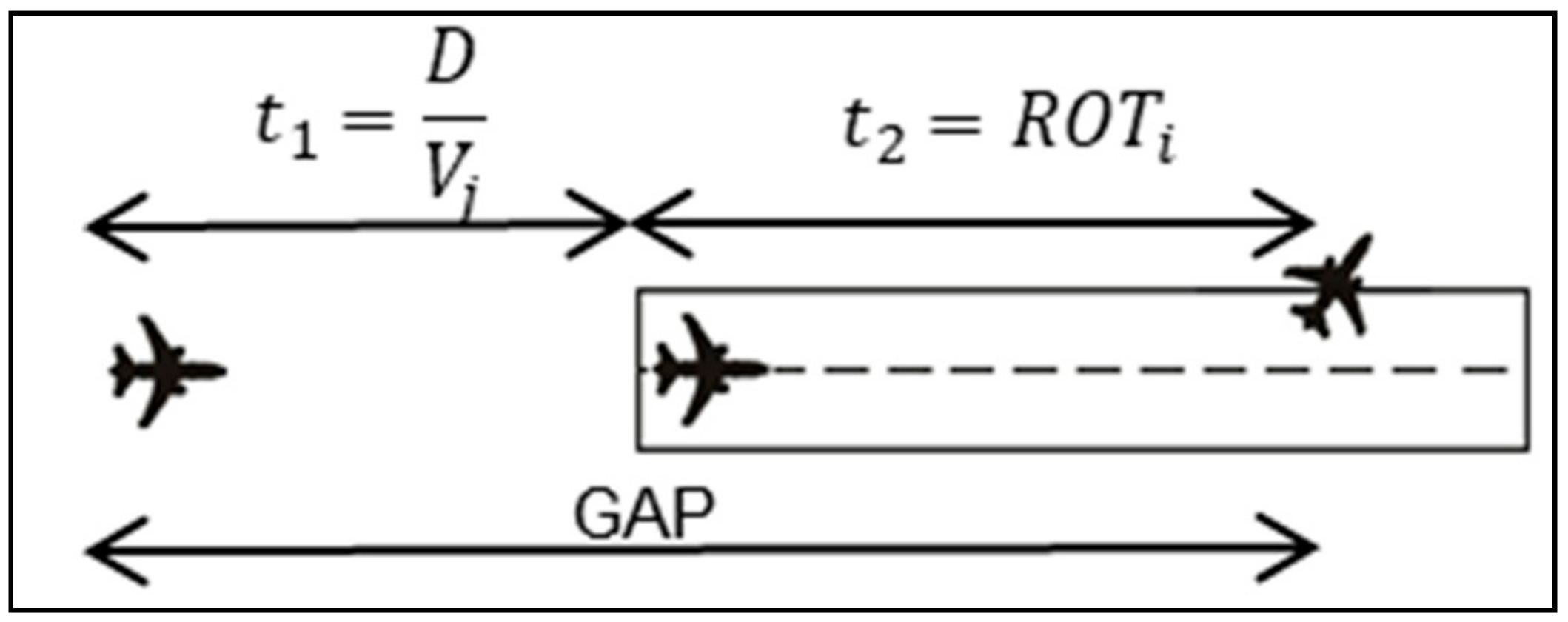



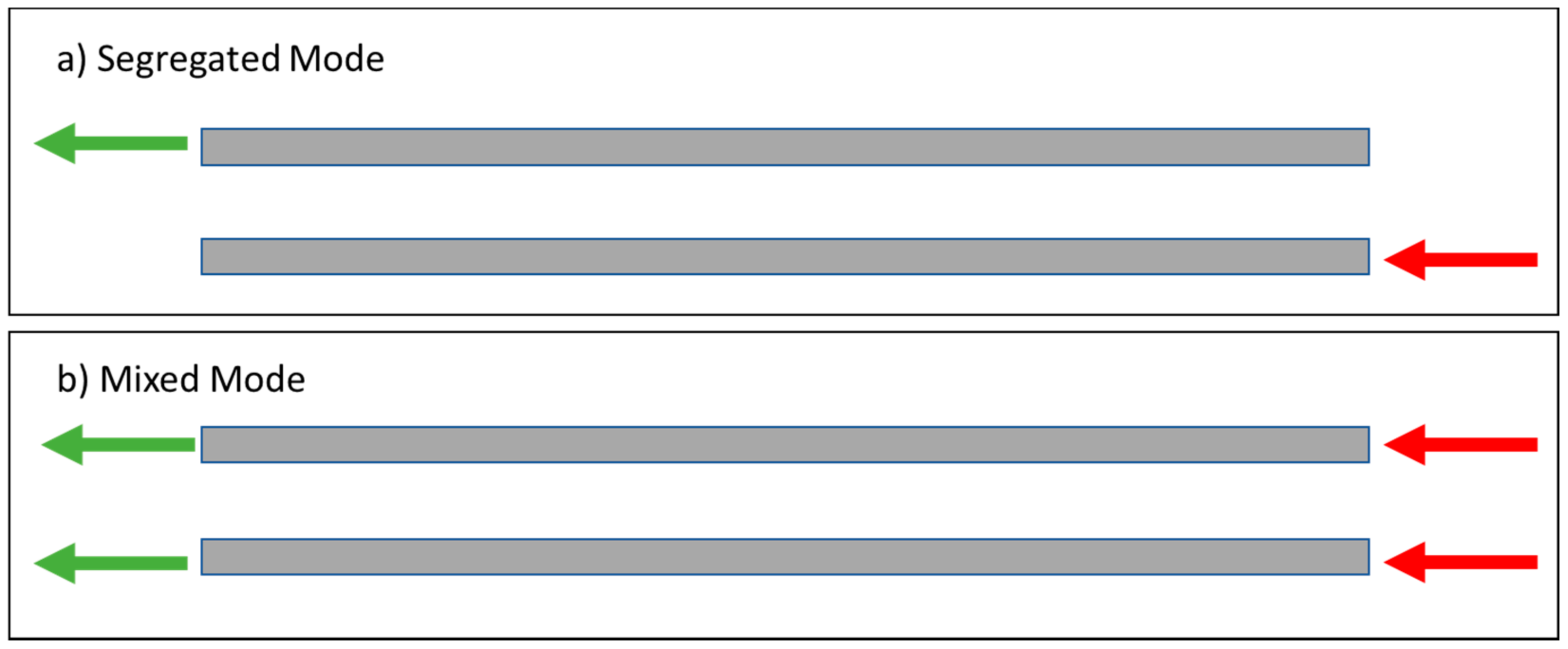


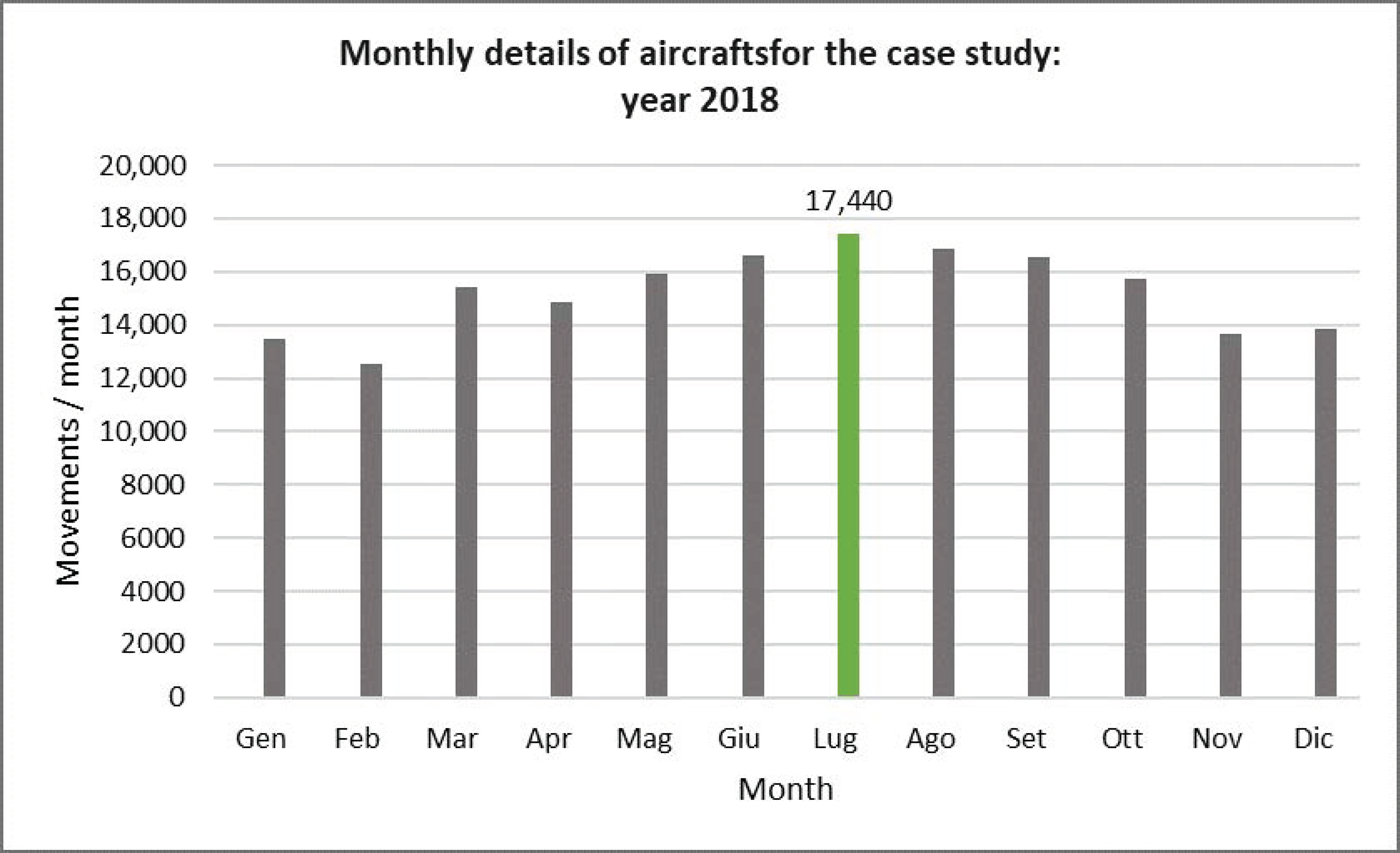

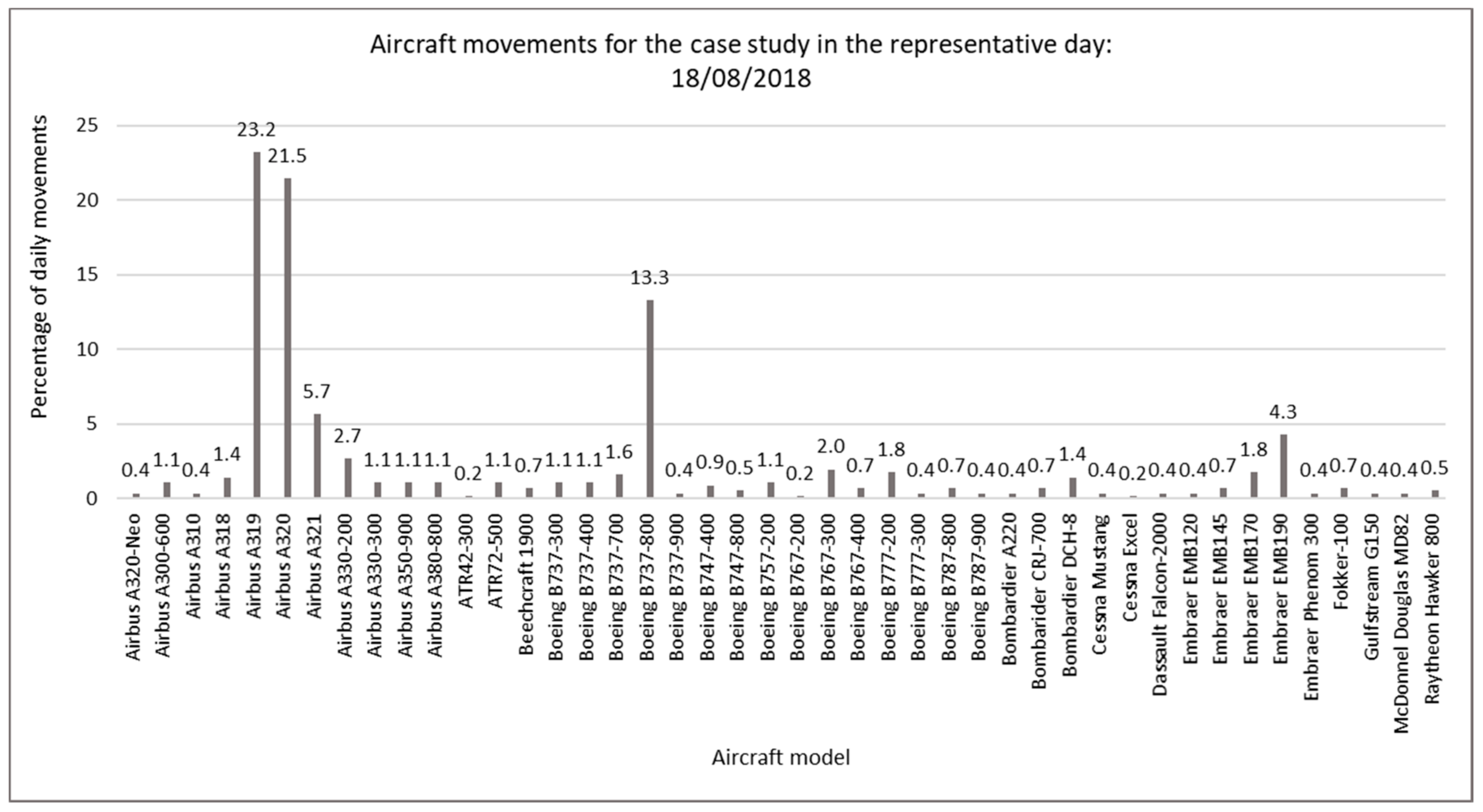
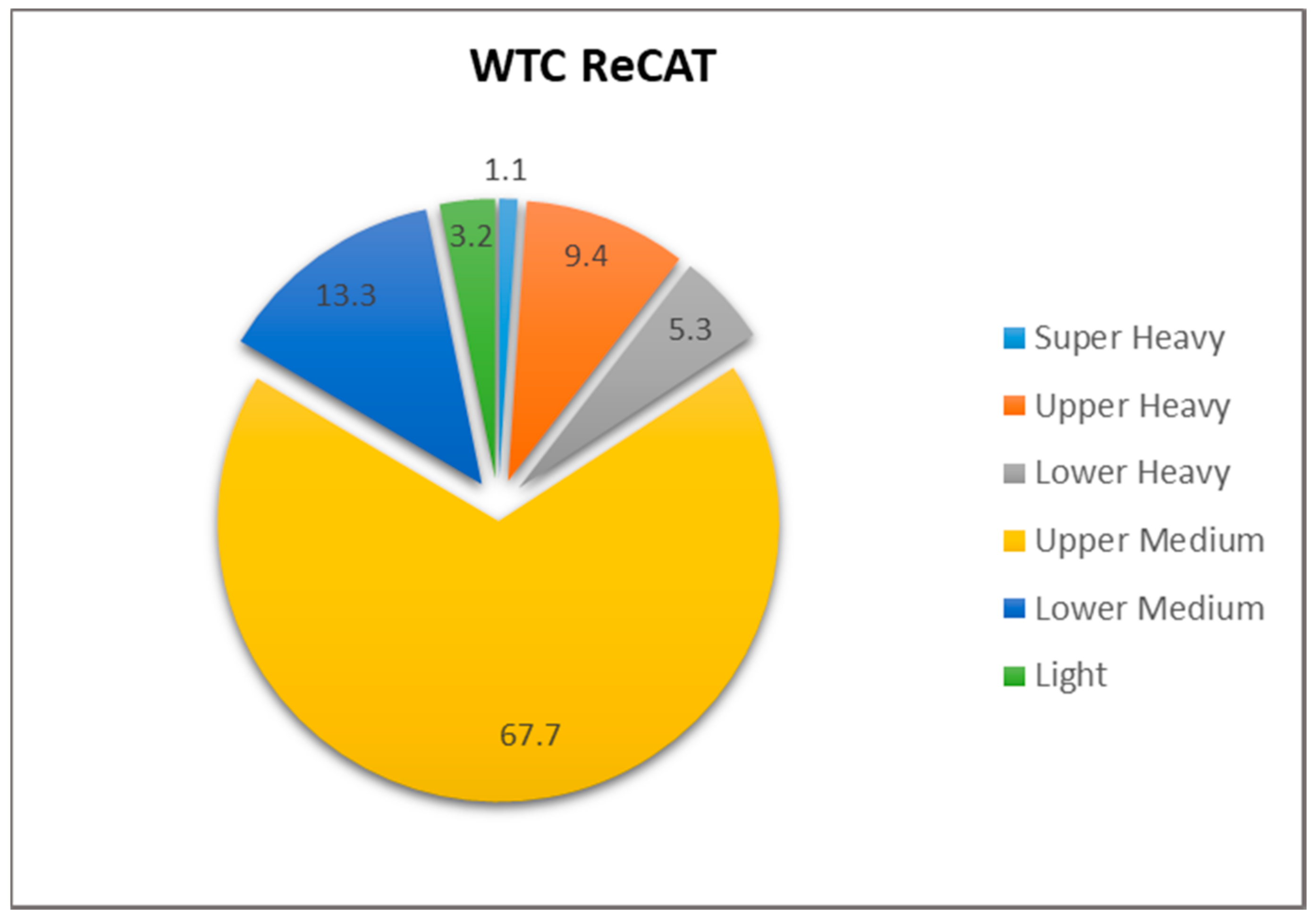
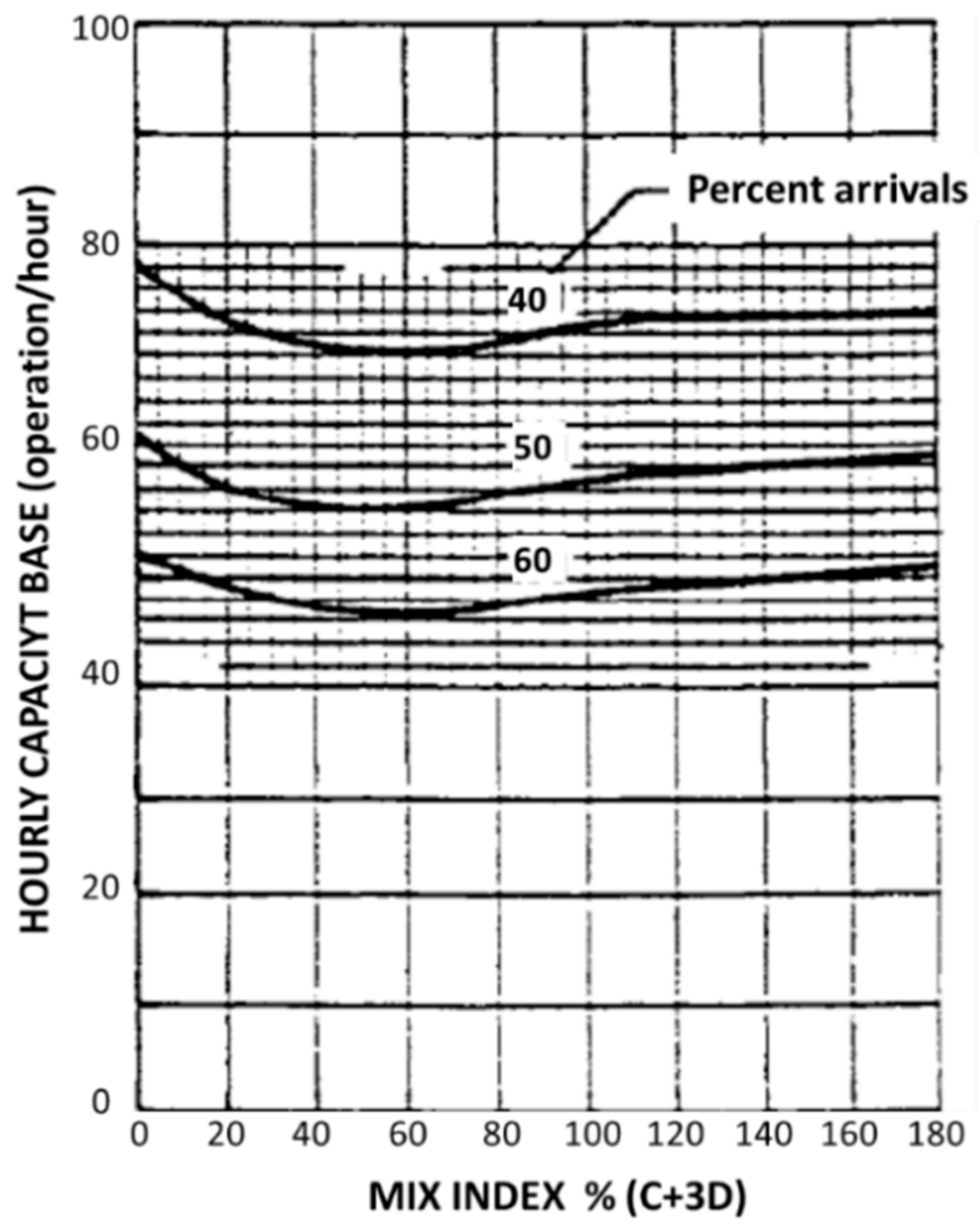
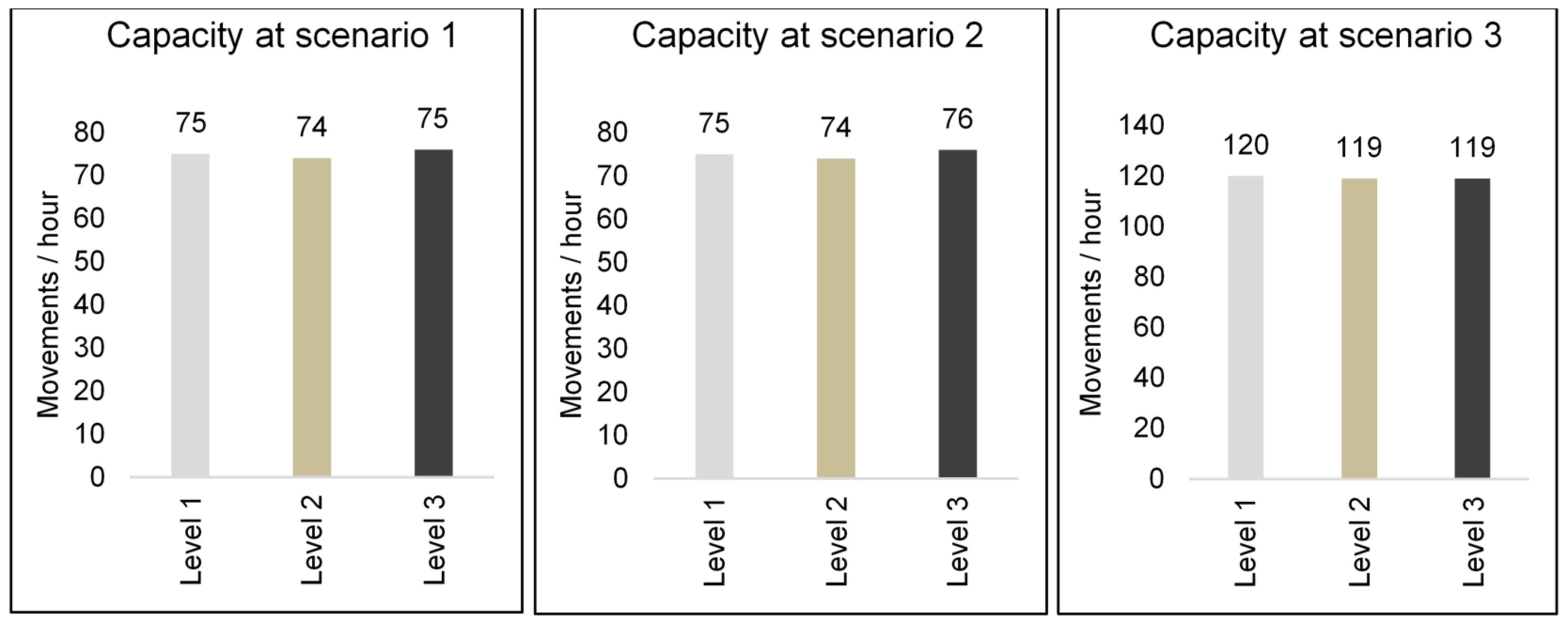


| WTC ReCAT | Aircraft |
|---|---|
| Super Heavy | Airbus A380-800 |
| Upper Heavy | Airbus A330-200, Airbus A330-300, Airbus A350-900, Boeing B747-400 Boeing B747-800, Boeing B777-200, Boeing B777-300, Boeing B787-800, Boeing B787-900 |
| Lower Heavy | Airbus A300-600, Airbus A310, Boeing B757-200, Boeing B767-200, Boeing B767-300, Boeing B767-400 |
| Upper Medium | Airbus A320-Neo, Airbus A318, Airbus A319, Airbus A320, Airbus A321, Boeing B737-700, Boeing B737-800, Boeing B737-900, McDonnel Douglas MD82 |
| Lower Medium | ATR42-300, ATR72-500, Boeing B737-300, Boeing B737-400, Bombardier A220, Bombardier CRJ-700, Bombardier DCH-8, Embraer EMB145, Embraer EMB170, Embraer EMB190, Fokker-100 |
| Light | Beechcraft 1900, Cessna Mustang, Cessna Excel, Dassault Falcon-2000, Embraer EMB120, Embraer Phenom 300, Gulfstream G150, Raytheon Hawker 800 |
| Aircraft Class | Maximum Take-Off Weight | Engines Number | Wake Turbulence Classification |
|---|---|---|---|
| A | <5.7 | Single | Small (S) |
| B | Multi | ||
| C | 5.7–136 | Multi | Large (L) |
| D | >136 | Multi | Heavy (H) |
| Input Level 1 | ||
|---|---|---|
| Mix Index | 129 | % |
| Runway separation 1 | 808 | m |
| Runway separation 2 | 1205 | m |
| Scenario | Runway Configuration from FAA AC 150/5060-5 | Hourly Capacity (IFR) | |
|---|---|---|---|
| 1 and 2 |  |  | 75 mov/hour |
| 3 |  |  | 120 mov/hour |
| Parameter | WTC ReCAT | |||||
|---|---|---|---|---|---|---|
| Light | Lower Medium | Upper Medium | Lower Heavy | Upper Heavy | Super Heavy | |
| ROT [s] | 55 | 55 | 52 | 53 | 50 | 48 |
| Mix Fleet [%] | 3.2 | 13.3 | 67.7 | 5.3 | 9.4 | 1.1 |
| Approach speed [kts] | 113 | 128 | 134 | 139 | 140 | 141 |
| Description | Parameter | Range (9), (10) | Adopted Value |
|---|---|---|---|
| Positional error of radar control systems | σ0 [s] | 18 [s]–8 [s] | 18 [s] |
| Probability of violation of the minimum distance | Pv [%] | 5 [%]–1 [%] | 5 [%] |
| Value in correspondence of which the function of the normal cumulative distribution is (1-Pv) | qv | 1.65–2.33 | 1.65 |
| Length of the terminal approach path | γ [NM] | 5 [NM]–10 [NM] | 7 [NM] |
| Additional Buffer on departure | t [s] | 5 [s]–30 [s] | 15 [s] |
| Departure/arrival separation | d1 [NM] | 3 [NM]–5 [NM] | 4 [NM] |
| Diagonal separation | d2 [NM] | 3 [NM]–2 [NM] | 3 [NM] |
| ROT standard deviation | σROT [s] | 8 [s]–4 [s] | 8 [s] |
Publisher’s Note: MDPI stays neutral with regard to jurisdictional claims in published maps and institutional affiliations. |
© 2020 by the authors. Licensee MDPI, Basel, Switzerland. This article is an open access article distributed under the terms and conditions of the Creative Commons Attribution (CC BY) license (http://creativecommons.org/licenses/by/4.0/).
Share and Cite
Mascio, P.D.; Rappoli, G.; Moretti, L. Analytical Method for Calculating Sustainable Airport Capacity. Sustainability 2020, 12, 9239. https://doi.org/10.3390/su12219239
Mascio PD, Rappoli G, Moretti L. Analytical Method for Calculating Sustainable Airport Capacity. Sustainability. 2020; 12(21):9239. https://doi.org/10.3390/su12219239
Chicago/Turabian StyleMascio, Paola Di, Gregorio Rappoli, and Laura Moretti. 2020. "Analytical Method for Calculating Sustainable Airport Capacity" Sustainability 12, no. 21: 9239. https://doi.org/10.3390/su12219239
APA StyleMascio, P. D., Rappoli, G., & Moretti, L. (2020). Analytical Method for Calculating Sustainable Airport Capacity. Sustainability, 12(21), 9239. https://doi.org/10.3390/su12219239







